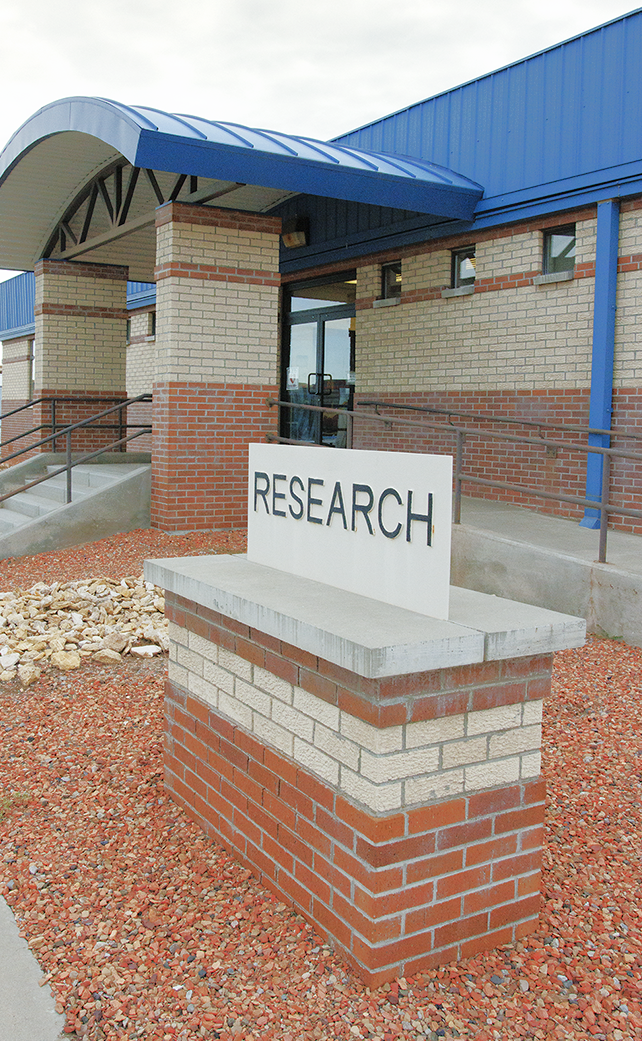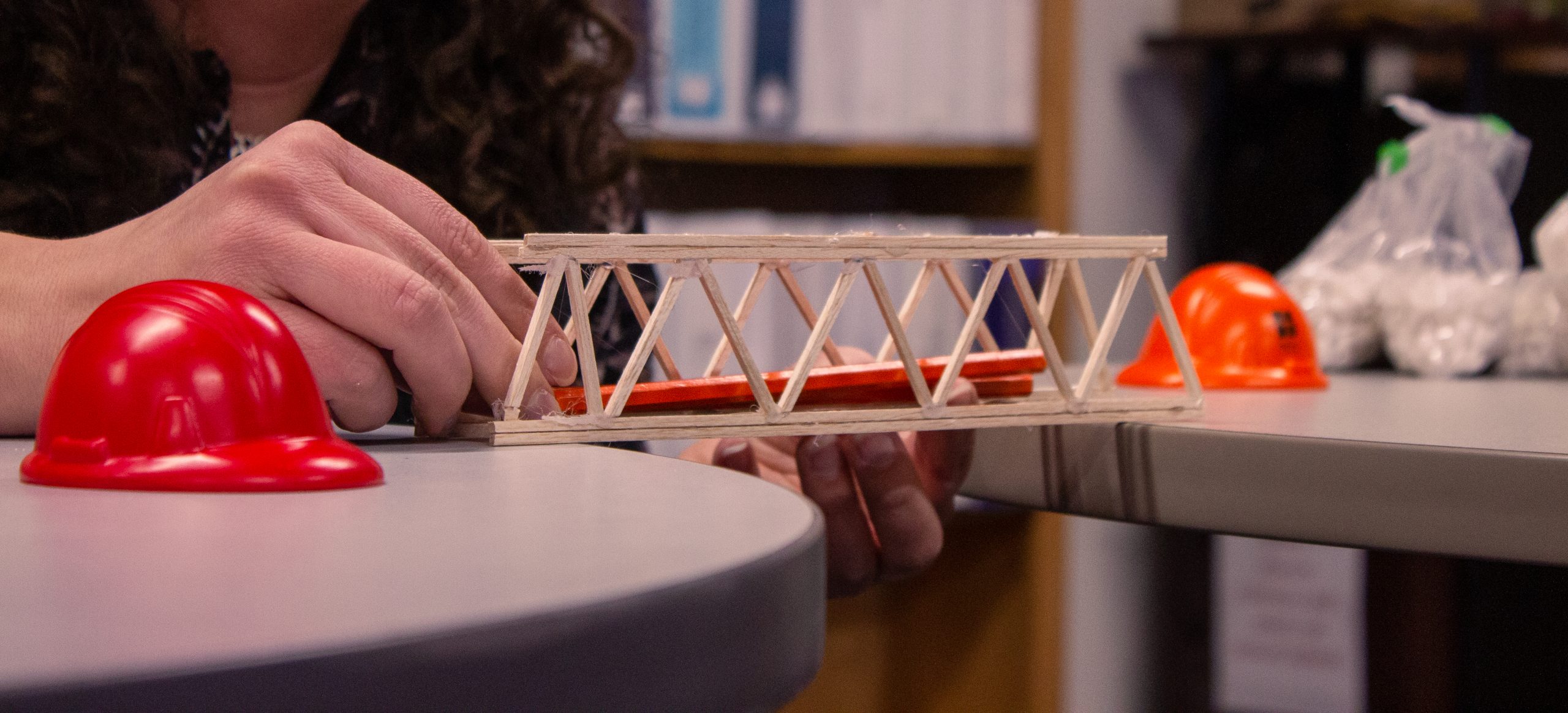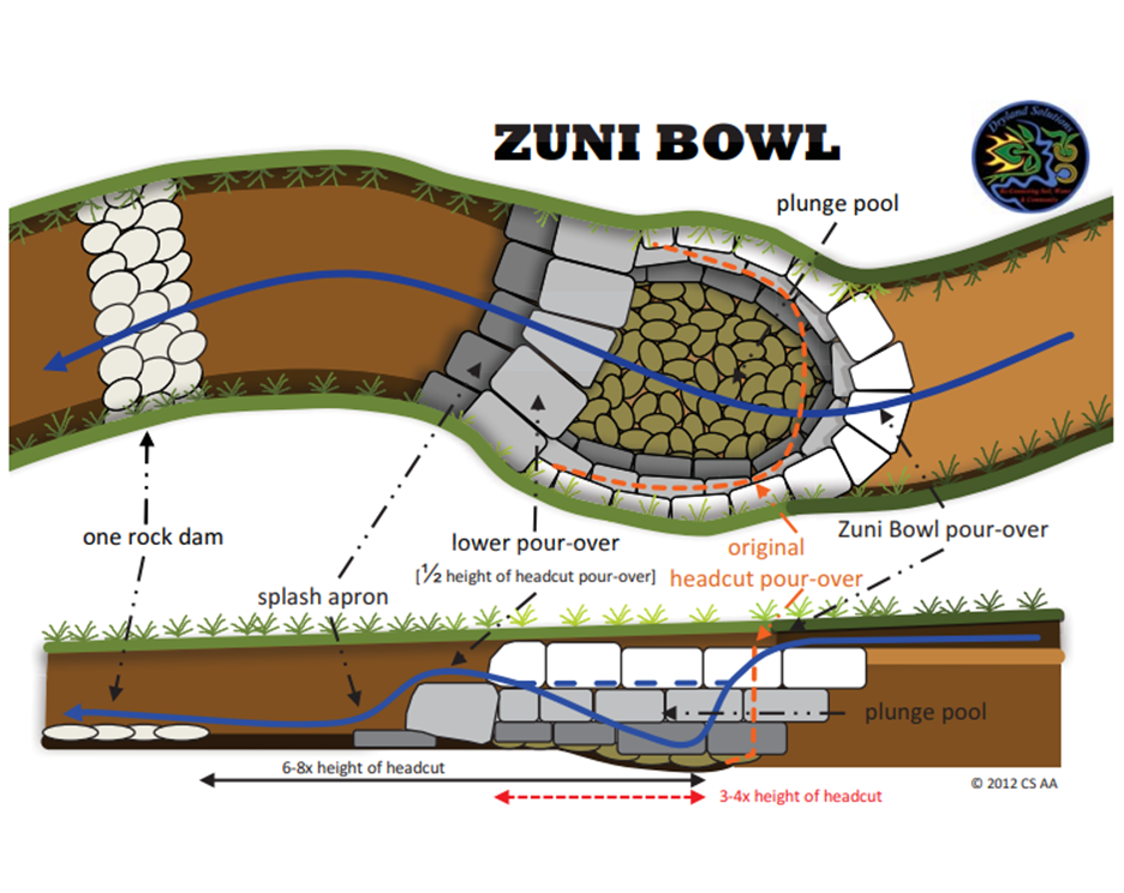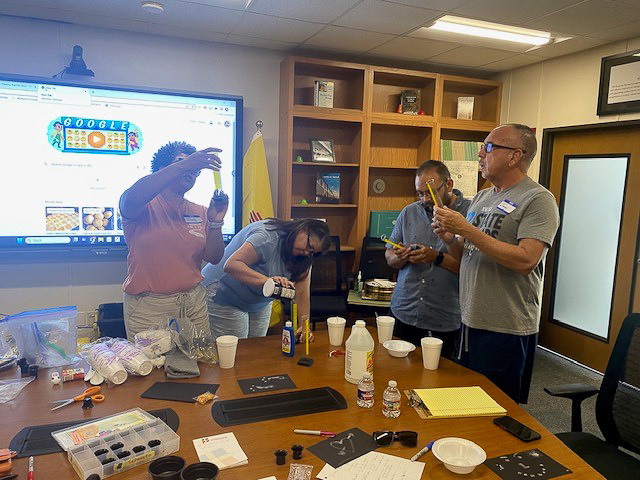Research and Climate Bureau
The Research & Climate Bureau (RCB) is part of NMDOT’s Planning Division. RCB is tasked with administering research projects and advancing climate change and resilience initiatives to support NMDOT’s ability to deliver safe, efficient, and resilient surface transportation to New Mexico.
The Research Team oversees all research projects; manages NMDOT Transportation Pooled Fund Studies; and staffs the Research Oversight Committee and New Mexico State Transportation Innovation Council (STIC) meetings and activities.
The Climate Action Team tackles climate change challenges related to transportation. The team helps to develop and implement adaptation, resilience, mitigation, and sustainability measures across NMDOT, including overseeing funding for key sustainability and resilience initiatives.
Randy Trujillo, Research and Climate Bureau Chief
505-469-4235 | Randolph.Trujillo@dot.nm.gov
Location:
7500B Pan American Freeway NE
Albuquerque, NM 87109

Research Team

Active Research Projects
R920050 – Determining Effectiveness of Wildlife-Vehicle Collision Mitigation Projects Phase II
The research is aimed at estimating passage rates or relative use of crossing structures for large mammals and identify other wildlife species using crossings at constructed and planned wildlife-vehicle collision mitigation projects for a 2-3 year period. In instances where fencing will be constructed during the study, we will compare use of crossing structures over time to evaluate the effectiveness of the fencing.
The specific objectives of this study are to:
- Compare wildlife passage rates or relative use of crossings with studies done in other western states.
- Identify infrastructure shortcomings or other factors that contribute to low passage rates or low relative use rates.
- Collate and review wildlife-vehicle collision and carcass collection data to determine the effectiveness of constructed projects in reducing wildlife-vehicle collisions, or at least document baseline wildlife-vehicle collision rates for planned projects.
- Create a guide for designing effective wildlife crossings and for improving existing drainage structures for mule deer (Odocoileus hemionus), elk (Cervus elaphus), black bear (Ursus americanus) and Mountain lion (Puma concolor).
R922030 – Solution to Interfacial Delamination of NMDOT’s Asphalt Pavements
To find a solution to delamination issues of New Mexico pavements, the project was initiated to identify and evaluate the following factors:
- Debonding of the tack coat from the top or bottom layer: due to poor interlayer bond caused by dissimilar material systems, improper choice of tack coat (type), lack of tack or application rate, inadequate or excessive breaking and curing of tack coat. It is worthwhile to mention here that the Department does not have acceptance or performance tests for tack coats.
- Failure within the layer: traffic- and pavement design related causes (e.g., slippage between layers due to heavy traffic, unstable or poor mix, excessive cyclic stresses at the interface of two layers)
- Damage and fracture within the interface or tack coat layer: caused by seepage of water through the surface layer, improper compaction, aging, and mismatch in thermal expansion and contraction between two layers and/or interface tack layer due to seasonal change in temperature.
R922040 – Develop a Balanced Asphalt Mixture Design Procedure
The NMDOT uses the Superpave method to design asphalt mixes which have shown poor cracking performance, although rutting performance is favorable. In a balanced mix design (BMD) approach, an asphalt mix will be designed to balance these two distresses; it will allow more rutting within a reasonable amount and reduce the long-term cracking.
The goal of this research is to develop a balanced mix design procedure, not only considering traffic and weather conditions of a region, but also performance driven rutting and cracking criteria.
The development of a step-by-step BMD procedure (mix volumetrics) will include multiple mix type (e.g., HMA and WMA), different performance grade (PG) binder content, aggregate gradation and type, and aging conditions.
R922050 – Conduct a Friction Testing Program, Data Analysis and Effectiveness of the NMDOT Open Grade Friction Course Program
The NMDOT conducts friction testing year-round on all state-owned roads and collected data are stored in database. There is a lack of guidance on what new roads should test at for open-graded friction course (OGFC), concrete, or chip seal, or any correlation with traffic safety, smoothness, or resurfacing criteria. Findings from this friction data focused research will be applied to pre- and post- OGFC, to determine if the friction courses are effective.
R922060 – Dust Mitigation Monitoring Project Phase II
NMDOT HSIP Dust Mitigation Projects. Since 2015, the New Mexico Department of Transportation has programmed $2.5 million in Highway Safety Improvement Program {HSIP) funds for dust mitigation activities at the Lordsburg Playa on both sides of I-10. In 2018, dust mitigation efforts in the Southern Playa {Road Forks) area were initiated including livestock exclusion, keyline plowing, printing, seeding, tackifier, and fencing. In 2020 and 2021, dust mitigation efforts in the Northern Playa area were initiated including livestock exclusion, channel/erosion control, keyline plowing, printing, seeding, tackifier and fencing. The objective of Phase II study is to determine the effectiveness of land use interventions on mitigating blowing dust and the frequency of dust-related traffic crashes
R923030 – Chip Seal for Uniform Usages
Chip seals are one of the most popular pavement preservation treatments for asphalt pavements due to their ability to seal the existing road surface from moisture damage and oxidation, improve skid resistance, seal minor cracks, and delay deterioration. They consist of a uniform spray application of an asphalt binder followed by a uniform application of aggregate coat cover which is then rolled with pneumatic tire rollers to achieve the desired embedment. This simple process can be conducted using local maintenance personnel with minimal equipment requirements, making it a cost-effective option.
NMDOT has not adopted a specific chip seal design procedure, and rather each district has independent methods to determine the material application rates, generally based on experience. The materials used vary throughout the state based on local availability. Recently, the use of reclaimed asphalt pavement (RAP) as chip seal aggregate has been adopted as an alternative to virgin aggregate due to the sustainability benefits associated with it.
The objectives of this research are to:
- Evaluate current NMDOT chip seal practices across the state of New Mexico, specifically materials and application rates. Assess the impact of these practices and/or factors on the performance based on available PMS database.
- Develop a chip seal design procedure, addressing both local materials and geographic conditions across the state of New Mexico.
- Develop statewide chip seal construction specifications.
- Develop project selection criteria for NMDOT to obtain optimum performance and treatment life from chip seal applications, such as skid resistance and minimum chip loss.
R923040 – GEOSYSTEMS Green Infrastructure
The objective of the research is to address future climate change and resiliency issues and mitigate the impacts to NMDOT’s rights-of-way by identifying areas where special environmental consideration and treatments should be considered.
This project will help the Environmental Bureau identify the areas where projects will have the most beneficial impact and will help NMDOT identify areas that should receive special consideration due to their environmental assets, such as habitat for endangered species, wildlife corridors, impaired rivers, areas with high biodiversity, etc.
Anticipated Benefits
- Protect NMDOT’s assets by addressing erosion and sediment deposition threats to existing infrastructure.
- Improve water quality by managing stormwater runoff.
- Decrease habitat fragmentation through ecological restoration and revegetation.
- Aid and protect numerous wildlife species including species such as pollinating insects and birds by planting and protecting pollinator habitat.
- Improve safety by reducing collisions with wildlife in important wildlife corridor areas.
- Improve air quality by capturing greenhouse gasses with an increase vegetative cover.
- Help identify wetland banking sites significant enough to address NMDOT future needs.
R923050 – Polymer Concrete Joints for Precast Bridge Elements
The overall objective of this project is to equip the New Mexico Department of Transportation (NMDOT) with the science and tools towards implementing a polymer concrete alternative solution for field joints of precast bridge members for accelerated construction.
There is a growing interest nowadays to find other alternatives and choices for bridge deck and ABC connections. Among potential candidate materials, the polymer concrete (PC) mixes stand out as an exceptional option for many reasons. PC can be sourced locally using more common and available materials and does not need to be proprietary, unlike UHPC that needs special additives and admixtures blends as well as steel fibers (which can be sometimes challenging to domestically source). PC provides much better mechanical properties (e.g., sustained tensile strength, superior bond behavior, high shear strength, etc.), durability, and flowability when compared to conventional concrete or standard grouts.
The polymer concrete alternative is to be comparable to what the NMDOT has recently implemented using ultra-high-performance concrete (UHPC) solutions. The NMDOT will leverage several years of research at the University of Nevada, Reno (UNR) in the area of polymer concrete and non-proprietary UHPC mix development and applications for accelerated bridge construction (ABC). UNR hosts world-class structural and large-scale testing facilities, as well as the materials laboratories under the Western Regional Superpave Center, to conduct a comprehensive experimental program that support the implementation tools that NMDOT requires.
R924020 – Comparing Resistivity and Conductivity in Metal Culverts
Currently, NMDOT uses the “2018 NMDOT Culvert Resistance Spreadsheet” (CRS) when estimating the service life of culverts. The values of resistivity in the CRS for different types of culverts of varying material (steel, concrete, aluminum, plastic, etc.) and of varying wall thickness with different corrosive inhibitor coatings were collected from manufacturers’ specification literature. With all these manufacturers’ values being reported in resistance (ohm-cm), it was assumed that the electrical conductance (milliSiemens per meter, mS/m) values reported by the Natural Resources Conservation Services (NRCS) for soils throughout NM were indirectly proportional to each other, based on Ohm’s law. Furthermore, the resistivity of the soil is determined in-situ adjacent to the culvert and the values reported by NRCS are from EC tests conducted in a lab from field-collected soil samples. These two methods, in-situ and laboratory are significantly different in procedure and produce values of different units, ohm-cm (resistivity) and mS/m (conductivity), respectively. It is assumed that the laboratory test is more accurate than the field tests, which will be evaluated in this proposed project. Providing a better understanding of and evidence that these two methods, although different, produce results that are indirectly proportional to each other will enhance NMDOT’s continued usage of their CRS when calculating service life of culverts.
The main objectives of this proposal are as follows:
- Conduct a literature review of similar work on culvert service life estimation coupled with field and laboratory analysis. Research various (inexpensive and expensive) in-situ and laboratory soil testing equipment to be used for this study and then provide recommendations for NMDOT.
- Test various (inexpensive and expensive) in-situ and laboratory soil testing equipment on approximately 20 sites throughout NM.
- Compare service life estimates to existing removed culverts with soil samples tested in-situ and in the laboratory and measure corrosive effects on these removed culverts.
- Validate the assumptions made in NMDOT CRS for culvert service life estimates.
- Adjust the CRS if needed.
R924050 – Aggregate Alkali-Silica-Reactivity and Mitigative Measures
Alkali-Silica-Reactivity (ASR) is a well-documented issue with aggregate used in concrete throughout New Mexico. Historically, we have relied on inexpensive coal fly ash (FA), a waste byproduct of power generation with pozzolanic properties, as an effective means of mitigating ASR. As more coal-fired power plants are retired and replaced by natural gas power plants and renewable energy sources, FA is no longer a reliably available source of material for mitigating ASR. Natural pozzolans currently used for ASR mitigation, such as pumicite and metakaolin, are available but costly. New Mexico has many undeveloped sources of alternative natural pozzolans which could be utilized with proper characterization and become a significant contributor to the State’s economy.
ASTM C1260 and C1567 are the most common tests used for quantifying potential aggregate-alkali-reaction (AAR), and the effectiveness of mitigation measures. They are quick tests that require roughly two weeks to complete. However, they can mischaracterize the AAR severity, and thereby the amount of mitigative material needed. Often, this mischaracterization is in the direction of increased reactivity, putting undue burden on a limited supply and increasing costs. Alternatively, ASTM C1293 is a long-term ASR test that takes one or two years to complete, depending on the testing parameters, and is much more accurate for characterizing potential AAR and the effectiveness of mitigative measures.
Unfortunately, very little ASR testing using C1293 has been performed on aggregate sources throughout New Mexico. This project proposes to explore the correlation between the shorter ASTM C1260 and C1567 tests and the longer C1293 test results using multiple aggregate sources from around New Mexico. ASTM, ACI, and AASHTO all strongly recommend developing a correlation between C1260, C1567, and C1293. The information obtained from this research will be used to better understand ASR in New Mexico and more accurately characterize the effectiveness of alternative SCM used for ASR mitigation.
Objectives
- The research objectives are to perform C1260, C1567, and C1293 testing on aggregate samples, different types of cements, and mitigative measures used in New Mexico concrete to establish a statewide aggregate reactivity database, and most importantly, relationships between short- and long-term testing methods to better inform testing recommendations and requirements for the implementation of performance-based ASR mitigation alternatives.
R924070 – Development of UAS-enabled Bridge Deck Inspection System from Investigation to Implementation
The NBI condition ratings serve as the fundamental basis for the collection of structural safety data during inspections. They enable the assessment of the physical state of bridge components, including the deck, superstructure, and substructure, by comparing them to their as-built condition. By taking into account the severity and extent of existing deterioration, these ratings provide an overview of the overall condition of the components. As the bridge deck is the component that is most directly impacted by traffic loads, it is crucial to maintain an accurate and current assessment of its condition. Regular inspections for bridge deck are essential for ensuring the safety and soundness of the entire bridge structure. To initialize the pilot project of UAS-based bridge inspection in component level, bridge deck is identified as the target component for this proposed project.
For this research project, the challenges for bridge deck inspection will be addressed by a UAS-based bridge inspection system with automated data collection and data interpretation. In the first stage, the automated data collection system will be developed. Where the UAS platform with various sensors will be developed. Then, preliminary flight testing will be performed for the developed UAS platform. Meanwhile, bridge deck data collection strategies for different sensors and environmental factors will be investigated. Finally, a recommendation will be developed for UAS-based bridge deck data collection under various scenarios. In the second stage, a data interpretation system will be developed. Where various data processing techniques and machine learning algorithms will be investigated to achieve reliable data interpretation that match the requirements for NBI rating systems. In the third stage, easy-to-use software will be built based on the algorithms developed in the second stage. In addition, the software will be implemented by using the field collected data and a tutorial will be prepared for NMDOT use. Last, the research outcomes from the proposed project will be delivered to NMDOT personnel as a technology transfer. A training workshop will be hosted to NMDOT personnel to gain knowledge of UAS-based bridge inspection. Besides, a site demonstration will be hosted to NMDOT personnel to show the developed UAS platform working on the site and software implementation. As a part of the research outcomes, a guideline for UAS based bridge deck inspection will be drafted.
R924090 – Advancing High RAP Asphalt Mixtures toward Pavement Sustainability and Net Zero Carbon Emissions
The state of New Mexico is facing a tough job of weathering climate change and designing a sustainable (carbon reduction) roadway system for the people. The New Mexico Department of Transportation (NMDOT) deals with extreme temperature rise, occurrence of wildfire, increased rainfall intensity, flooding, extended summers, and more severe droughts. These natural hazards and ever-increasing material and construction costs have wrought significant damage to the roadway network throughout the state. Modem asphalt mixture designs not only prepare new and existing roadways that are not immune to climate change, but also provide economic and social opportunities for the people, especially in remote and rural areas, creating inclusive and connected economies.
Carbon emissions are a significant component of pavement sustainability and resilience. In 2022, the asphalt pavement industry in the United States established goals for climate stewardship to achieve net zero carbon emissions by 2050. The industry has also identified significant tactics, research, and implementation gaps required to achieve those goals, including the appropriate use of reclaimed asphalt pavements (RAP) and other recycled materials in asphalt mixtures. According to the most recent asphalt pavement industry survey, the average RAP content in asphalt mixtures for New Mexico is around 20%, which is slightly lower than the national average. Using more RAP will provide NMDOT with significant cost savings and reductions in carbon emissions associated with the production of asphalt mixtures and the construction of asphalt (flexible) pavements.
This project will advance the responsive use of high RAP asphalt mixtures in New Mexico, providing NMDOT with significant cost savings and improved transportation systems for the traveling public. Increasing the RAP content in asphalt mixtures from 20% to 40% while improving pavement performance could reduce the material cost by $10 per ton and reduce carbon emissions by 8%. These economic and environmental benefits would be substantial to NMDOT and the people of New Mexico, considering that over 3.5 million tons of asphalt mixtures are produced annually across the state. This research will also position NMDOT at the forefront in advancing pavement longevity and sustainability while allowing NMDOT to participate in USDOT’s national efforts and collaborate with other state DOTs interested in using high RAP asphalt mixtures.
The overall objective of this research is to advance high RAP asphalt mixtures toward pavement sustainability and net zero carbon emissions in New Mexico. Specifically, the research seeks to
- Develop mix design strategies to improve the long-term pavement performance and life span of high RAP asphalt mixtures.
- Determine the multi-cycle recyclability of high RAP asphalt mixtures.
- Quantify the economic and environmental benefits of high RAP asphalt mixtures through LCCA and LCA
R925020 – Calibrate of Pavement Mechanistic-Empirical Design (PMED) Software to New Mexico’s Pavement Conditions
The NMDOT’s current flexible pavement design procedure (i.e., AASHTO 1993) is empirically based and developed based on limited AASHTO road tests during the 1960s. This empirically based pavement design procedure cannot predict pavement performance accurately and is typically conservative. Recently, more than thirty (30) years of pavement research and experience have been compiled into a comprehensive document and corresponding software called the AASHTO Pavement Mechanistic-Empirical Design (PMED) software. The PMED (formerly known as MEPDG) can better predict pavement performance through better utilization of local materials, factors such as present-day traffic conditions, and regional climate, as opposed to the traditional empirical design methods. Therefore, the NMDOT needs to use this software. The use of PMED will result in significant improvements in pavement design, including savings from the selection of more economical combinations of materials and thickness. Yet, the input parameters and calibration coefficients addressing the conditions prevalent in New Mexico for ensuring an accurate design using the PMED are unknown.
The main objective is to perform local calibration of the PMED, that is, the process of adjusting the distress model coefficients to account for model limitations in predicting the NMDOT’s pavement behavior.
R925030 – Determining New Mexico Harvested Fly Ash Quality for Deployment in Durable Concrete Mix: Laboratory Assessment and Micro-Modeling
The main project objective is to assess the viability and reliability of the use of disposed fly ash available in the six (6) federally operated coal ash ponds and landfills in New Mexico. A series of tests will be performed on boring samples for laboratory characterization, which will include ASTM C618 for the characterization of bulk composition, fineness, loss-on-ignition, and moisture content, and ASTM C1897 for rapid characterization of pozzolanic activity. Special attention will be given to collecting representative fly ash samples corresponding to different portions of a given storage unit. In addition, parameters such as set time, elastic modulus, and compressive strength will be evaluated by testing different concrete formulations with and without the disposed fly ash. Based on the experimental findings, a micro-model will be developed to better quantify the effect of disposed fly ash chemistry on cement hydration. Cement hydration will be simulated and will include explicitly the composition of fly ash. A mechanistic model will also be developed to capture the evolution of the mechanical properties of concrete with harvested fly ash. In conjunction with experimental data, the model results will be used to assess the production quality of durable concrete with New Mexico-harvested fly ash. Finally, a series of validation tests will be performed and include ASTM C191 for initial and final setting times, ASTM C109 for compressive strength development, ASTM C469 for elastic modulus determination, and ASTM C456 for consistency in the setting and strength development process, ensuring reproducibility and reliability of the experimental results.
R925040 – Study and Evaluation of Materials Response in Hot Mix Asphalt Based on Field Instrumentation (Phase IV)
The instrumented pavement section at Interstate I-40, near Albuquerque, New Mexico (Dist. 3) has been providing stress-strain data that are needed for full implementation of the pavement mechanistic empirical design (PMED) software in New Mexico. Phase III study has recommended for consideration of additional instrumentation sections under different structural types, weather patterns, and loadings. As the I-40 pavement section can still provide valuable pavement design and material response data, Phase IV is proposed to continue data collection using this instrumented section.
After the Phase III study, it was observed that the AC layer had sustained damage, amounting to 13% between 2012 and 2024. This damage is attributable to traffic (45%) and environmental factors (55%). The general understanding is that most of the damage to the pavement occurs due to traffic loading. The findings from Phase III showed that in desert climatic conditions, the environmental factors can cause significant damage to the pavement compared to traffic. Weather data analysis for the past twelve (12) years showed that temperature can differ more than 20°F at the instrumentation section between day and night. Unfortunately, to this day, pavement mechanistic empirical design (PMED) methodology cannot directly accommodate environmental loading. The damage progression data in the future from this study can be useful to develop a pavement model that can incorporate both the traffic and environmental loading directly. Like the last three phases, the field measured stress-strain values at different layers of the instrumented I-40 section under different truck loads can be compared with the PMED software-predicted stress-strain data. Field performance data are needed for the validation of locally calibrated PMED models for New Mexico. Indeed, this pavement section was designed to serve twenty (20) years. Therefore, it will be interesting to determine whether this pavement section is over-designed or under-designed. So far, this pavement has shown very little distress, and the distress data are not sufficient to validate the input and distress models included in the PMED software. Data should be collected for a sufficient period so that there is a pattern or clear trend in the data that helps identify significant changes in properties/characteristics of inputs and performances that occur in the field pavements under local traffic and climate. Therefore, a Phase IV study is needed to collect data from this instrumented section and use it to implement (locally calibrated) PMED software in New Mexico.
The main objectives are to collect and analyze time series of sensor stress-strain, traffic, materials, weather, and performance data for long enough to be useful for validation of a locally calibrated PMED software for New Mexico.
R925050 – Determine the Optimum Dosage of Rejuvenators Based on the RAP Contents as well as the PG Grade of Recovered RAP Binder
An asphalt binder is essentially composed of two main fractions: asphaltenes and maltenes. The asphaltenes (solid) are dispersed within the maltenes phase (liquid) in an asphalt binder. Asphaltenes consist of high molecular weight compounds with a high concentration of aromatic rings, carbon, and sulfur, and contribute to the binder’s stiffness, rigidity, and resistance to flow. Maltenes are the lighter, less polar components of asphalt and typically consist of saturates and resins, which contribute to the binder’s fluidity and adhesion (glue). Field pavements are exposed to sun, water, and air, which oxidize the asphalt molecules, creating carbonyl and sulfonyl molecules. As such, oxidation changes the ratio of maltenes to asphaltenes and makes the asphalt binder harder and brittle. A general concern associated with the use of aged asphalt binders in a new or virgin binder is that the resultant binder is too stiff and consequently prone to cracking. However, the use of a rejuvenator in aged asphalt binder can reverse the effects of aging by balancing the ratio of maltenes (fluid) to asphaltenes (solid).
Reclaimed Asphalt Pavement (RAP) is generated when materials from pavements in service are removed or milled, crushed, and processed. The inclusion of RAP in a new hot mix asphalt (HMA) introduces an aged binder into the mixture that can be susceptible to cracking. However, as an alternative supply of both aggregate and old/aged binder, the use of RAP effectively cuts the cost of HMA production. This aspect has caused much of the paving industry to look more seriously at increasing the use of RAP material. According to the latest survey by the National Asphalt Pavement Association (NAPA), the use of RAP tonnage has increased by 75.2 percent nationwide since 2009. RAP usage during the 2022 paving season has reduced the need for an estimated 26.9 million barrels of asphalt binder and more than 93 million tons of aggregate.
The NMDOT allows the contractors to use RAP up to 35% in the production of HMA mixtures. Using RAP more than 35% exposes greater potential to produce stiff mixes, which are difficult to compact, prone to fatigue and other cracks, and result in poor pavement performance. Unfortunately, the NMDOT does not use any rejuvenator to soften the RAP binder; rather, it uses a softer binder in a RAP mix. As such, NMDOT lacks in lowering the compaction temperature of RAP asphalt or in maximizing the benefits of RAP usage in NMDOT pavements, or from the fact that binders with rejuvenators perform better than NMDOT’s traditional performance grade (PG) binders. There is a need for evaluating and characterizing the performances of rejuvenator-treated RAP binders to maximize the RAP usage as well as other benefits of rejuvenators in asphalt binders.
Both petroleum-derived oils and plant-based bio-oil rejuvenators are available to restore the properties of aged binder. Petroleum-based rejuvenators mainly contain maltenes that reverse the effects of aging by balancing the ratio of maltenes to asphaltenes. Petroleum-based rejuvenators can be thought of as supplements of maltene components. Bio-based rejuvenators increase the dispersion of asphaltene in the maltene fraction by diffusion and penetration into the RAP binder film, and they are known to be environmentally friendly. There are several rejuvenator manufacturers, for example, Cargill, Kraton, Ingevity, Collaborative Aggregates LLC, Pavement Technology LLC, and Georgia-Pacific Chemicals LLC. They all claim that their products can restore aged asphalt binders. Some of these products are solely softening agents and penetrate the deeper layer of RAP to soften the aged and oxidized asphalt binder. Others may have the ability to chemically adjust the maltene fraction of an asphalt binder.
R925060 – Quantifying Portland-Limestone Cement Chemical and Physical Characteristics Affecting Concrete Quality
The primary objective of this study is to comprehensively evaluate the use of PLC with higher limestone content (5-20%) to address performance concerns and support its effective adoption in sustainable concrete practices.
There are five specific objectives of this research:
- Examine the Challenges of Using High-Limestone PLC: Identify and analyze the issues associated with using blended cements containing a broad range of limestone contents, with a focus on understanding their impact on concrete quality and performance.
- Analyze the Chemical Composition of PLC: Establish a thorough chemical profile of PLC used in New Mexico, assessing the consistency and variability in composition. This analysis aims to provide insights into the chemical interactions within PLC and compare results against industry standards for quality assurance.
- Characterize the Physical Properties of PLC: Evaluate the key physical characteristics of PLC, including particle size distribution and morphology, to understand their influence on concrete properties such as strength, workability, and durability.
- Investigate the Interaction with New Mexico Aggregates and Supplementary Cementitious Materials (SCMs): Assess the interactions between PLC, locally sourced New Mexico aggregates, and common SCMs like fly ash and natural pozzolans. This investigation will focus on understanding the combined effects on hydration, setting behavior, aggregate-PLC bond strength, and the long-term durability of concrete mixtures.
- Develop Recommendations for Optimized Use: Synthesize the findings from the chemical and physical assessments to provide evidence-based guidelines for optimizing PLC formulations and concrete mixture proportions. The goal is to enhance performance, ensure long-term durability, and support the reduction of the carbon footprint in concrete applications.
Final Research Projects
Our Research team partners with NMDOT experts, regional universities, and consultants to research challenges facing the state’s transportation systems. The Research Team manages research projects, promotes implementation, coordinates with national research organizations, and evaluates outcomes. Other activities include:
- NMDOT Transportation Pooled Funded Studies (TPF)
- AASHTO STEM Outreach Solutions for the State of New Mexico
- New Mexico State Transportation Innovation Council (STIC) meetings and activities
- State Peer Exchange
- Research Oversight Committee (ROC)
Contact Us
Research Operations-Vacant
Angelo Armijo, Staff Manager
505-372-8757 | Angelo.Armijo@dot.nm.gov
Shannon Vigil, Program Coordinator
505-690-0561 | Shannon.Vigil@dot.nm.gov
Abigail Moya, Project Manager
505-269-6492 | Abigail.Moya@dot.nm.gov
Tesha Henderson, Project Manager
505-699-6266 | Tesha.Henderson@dot.nm.gov
Amy Boggess, Librarian
505-618-0572 | Amy.Boggess@dot.nm.gov
Climate Action Team
The Climate Action Team helps our State address climate change challenges related to transportation. The Climate Action Team oversees funding for three key initiatives:
- Congestion Mitigation and Air Quality (CMAQ)
- Carbon Reduction (CR)
- Promoting Resilient Operations for Transformative, Efficient, and Cost-saving Transportation Program (PROTECT)
CONTACT US
Sharon Cruz, Climate Action Team Manager
505-221-8220 | sharonr.cruz@dot.nm.gov
Mariana Santiesteban, Climate Action Program Coordinator
Carbon Reduction & CMAQ Programs
505-670-2189 | Mariana.Santiesteba@dot.nm.gov
Gerald Lujan, Climate Action Program Coordinator
Resilience/PROTECT Programs
505-469-9934 | Gerald.Lujan@dot.nm.gov
KEY RESOURCES
NMDOT Carbon Reduction Strategy (2023). To meet the requirements of 23 USC 175(d)(1) and advance the goals of Governor Lujan-Grisham’s Executive Order 2019-003 “On Addressing Climate Change and Energy Waste Prevention,” NMDOT developed and adopted a State Carbon Reduction Strategy. The Carbon Reduction Strategy supports NMDOT’s efforts to reduce transportation emissions and identify projects and strategies to reduce those emissions. The Strategy was developed in coordination with the state’s Metropolitan Planning Organizations and Regional Transportation Planning Organizations.
The Carbon Reduction Strategy reflects the state’s commitment to reducing greenhouse gas emissions, mitigating climate change, and fostering a more sustainable and environmentally responsible transportation system. The CRS outlines a comprehensive approach to address transportation emissions and promote cleaner transportation practices, aligning with NMDOT’s core values and long-term goals.
NMDOT Resilience Improvement Plan (2024). The Resilience Improvement Plan (RIP) utilizes a data-driven approach to identify existing transportation assets that are good short-term candidates for resilency upgrades. NMDOT staff can use the plan to identify potential environmental hazards that should be considered when planning, constructing, and repairing transportation assets. Implementing the RIP can help strengthen the resilience of our transportation system to environmental hazards and emergencies (such as flood, fire, or rockfall).

RESILIENCE RESOURCES
FHWA Vulnerability Assessment and Adaptation Framework
FHWA Adaptation Decision-Making Assessment Process
Dust Control
Dust Storm Mitigation & Safety
Revegetation Zones & Seed Lists
The Effort to Restore the Lordsburg Playa
Stormwater Management
FUNDING FOR MITIGATING CLIMATE CHANGE IN TRANSPORTATION
Congestion Mitigation and Air Quality Improvement Program (CMAQ).
The Congestion Mitigation and Air Quality Improvement Program (CMAQ), provides a flexible funding source to the State and T/LPAs for transportation projects and programs that help meet the requirements.
Carbon Reduction Program.
The Carbon Reduction Program (CRP) provides reimbursement funding for projects designed to reduce transportation carbon dioxide (CO2) emissions from on-road highway sources. Funds from CRP may be obligated for a wide array of projects that support the reduction of transportation CO2 emissions. The most current program guide is available for download below.
PROGRAM RESOURCES AND GUIDES
- NMDOT CMAQ Program Guide 2023
- CMAQ Application Form 2023 (Word)
- CMAQ Application Form 2023 (Fillable PDF)
- NMDOT Carbon Reduction Program (CRP) Guide 2024+
- CRP Application Form 2024 (Fillable PDF)
- FHWA CMAQ Factsheets and Reference Materials
- FHWA CMAQ Emissions Calculator Toolkit
- FHWA Guideance and Regulations
- FFY2026+ NMDOT CMAQ CRP Program Guide
Recent Projects and News

Fall 2024
Zuni Bowl and One Rock Check Dam Research
A series of erosion control structures involving rocks, water, biology, and time are being built to mitigate small channel head cuts across the state of New Mexico. The structures are Zuni Bowls followed by a One Rock Check Dam: a small plunge pool that is constructed of hand placed rip rap or native rocks followed by a small check dam that is also constructed of hand placed rip rap or native rocks.
- Zuni Bowls stabilize actively eroding headcuts by dissipating the energy of falling water at the headcut pour-over and the bed of the channel.
- Zuni Bowls also serve to maintain soil moisture on the face of the headcut, encouraging the establishment of protective vegetation.
- Original concept developed by Bill Zeedyk and the people of Zuni Pueblo.

Summer 2023
Mountain View Middle School-Rio Rancho, NM participates with AASHTO STEM Outreach Solutions Program
On July 12-13, 2023, Mountain View Middle School-Rio Rancho, NM, participated in a 2-day training conducted by educators of the American Association of State Highways and Transportation Officials (AASHTO). MVMS is partnering with NMDOT to implement the AASHTO STEM Outreach Solutions (ASOS) program at their school beginning this year. AASHTO educators, Cindy Steven-Pheal, 6th grade gifted teacher and Connie Gusmus, 7th grade science teacher lead MVMS teachers, Jimmy Marez, Julie Evans, and Christopher Tafoya in one of the many STEM activities provided with this program. Pictured, MVMS teachers participate in the Growing Crystals activity. This activity focuses on measurement, evaporation, scientific inquiry, and states of matter. MVMS is utilizing the Roadways Into Developing Elementary Students (RIDES) module, designed as an introductory to the STEM Outreach Solutions program, specifically for elementary and middle school students. For more information on ASOS, click the AASHTO STEM Outreach Solutions link above under Programs.
